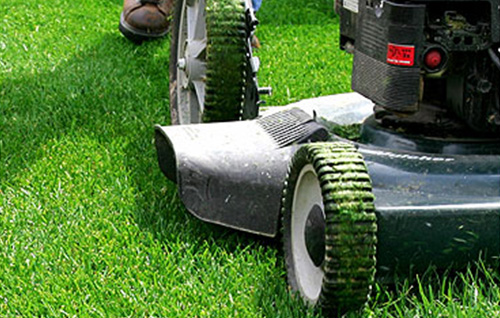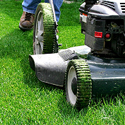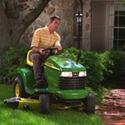
When should you start mowing?
Start each spring by cutting the lawn before it turns green and begins growing. Clipping off the old dead tips gives the lawn its cue to start growing. The sooner you get the lawn growing the better you can crowd out the weeds before they start.
How often should you mow?

Normally, weekly mowing is the rule, but some lawns need cutting more often. Other lawns will grow more slowly and might need cutting only once every ten days or two weeks. Generally, don’t cut off more than one third of the grass blade. More than that may harm the grass. Let the length of the lawn be the judge, NOT when the lawn was last mowed.
Mowing Tips
Always have sharp blades. Dull mower blades tend to rip the blades of grass as opposed to cutting them. Every torn blade is an opening for disease and causes stress to the lawn. Mowing a lawn when it is wet tends to cause the same problem, so try to avoid it if possible. If you do mow when the lawn is wet, you’ll end up with ruts, and the grass will begin to lean over making it difficult to get a good cut.
As long as you have a healthy lawn already and no problems with thatch, feel free to leave the clippings when you mow. Mulching is good, but it is not a necessity. As long as the clippings are not excessive, they will not harm your lawn. The clippings will break down within a short period of time and will provide nitrogen to your lawn.
The perfect mowing schedule doesn’t mean keeping it the same from Spring to Fall. Your mowing schedule should change with the season and growing conditions. It’s important to keep it regular and don’t skip a cut.
First Cut
Lower the cutting height to about 2” and bag the clippings. You’ll vacuum up the dead debris and dust, plus fluff up the matted down grass increasing air flow and reduce the effects of snow mold.
May to Mid-June
Increase mowing height to 2½-3”. Cooler weather, spring rains and fertilizer all accelerate grass growth. Mow at least once a week. Twice a week might even be better during times of rapid growth.
Mid-June to Late August
Hot & dry weather slows growth rates. Mow once weekly but raise mowing height to 3” minimum to conserve moisture and shade soil and roots from intense heat. Regular mowing discourages the spread of Quack grass.
September to October
Cooler weather and increased rainfall mean you can lower your mowing height to spring levels. Continue mowing once a week.
Final Cut
For the last cut lower mowing height to 2” just like the first cut of the year. Lower heights discourage voles and reduce snow mold damage next spring.
Let it Grow

The longer you let your lawn grow (speaking in terms of length, not necessarily time) the longer your lawn’s root system will grow. The longer the root system, the healthier and more stress resistant your lawn will be. The more stress and drought resistant your lawn, the less watering that has to be done. In addition, tests have shown that letting the lawn grow to lengths of 2½-3″ reduce the number of weeds in the lawn by reducing the amount of sunlight reaching the weed seeds. Longer blades also have more surface area available for photosynthesis, which produces life-giving food and energy for the lawn.
For the last cut of the season, make it a short one. Leaving the lawn short for the winter reduces the chance of matting that contributes to winter kill damage.
